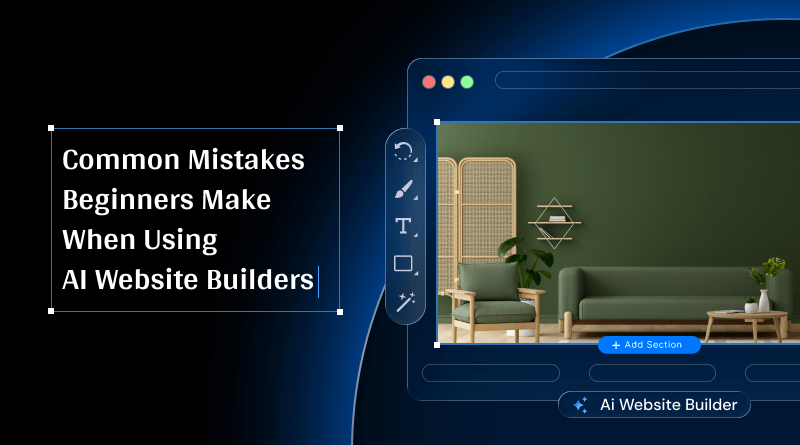Building a website no longer needs a developer’s desk or a month-long timeline. With AI tools pitching “ready in minutes” websites, many beginners expect polished results by default. But fast doesn’t always mean right. And when shortcuts skip over strategy, you end up with a pretty front and a broken back-end.
Here’s what most new website owners miss: the real work begins after you hit “Publish.” This is where most AI website builder mistakes begin—not from lack of effort, but from an overreliance on automation and underestimation of what makes a website truly effective. Things like performance, mobile usability, branding consistency, and backend control can’t always be solved with templates or toggle switches.
That’s why some users move their AI-built websites to more reliable environments like WordPress hosting—for better scalability, flexibility, and to gain actual ownership over their website infrastructure.
But before we get there, let’s talk about the early traps people fall into and how to avoid AI website builder mistakes smartly.
Table Of Content
Mistakes to Avoid When Building Your Website with AI
Mistake #1: Completely depending on AI-Generated Content
This is one of the most common AI website builder errors. AI can give you a headline, a few paragraphs, and even a product description. However, it can’t replace your brand voice; it certainly doesn’t convey to your audience the way you do.
- Why does it matter?
- Visitors can spot generic content the moment they land on your website. If your About Us page sounds like it was copied from a dozen other websites, you’re missing an opportunity to connect. If your content seems recycled, don’t expect it to hold a strong search ranking.
- What to do instead?
- Use AI content as a preliminary draft, not as the final version. Write like you talk. Add real customer testimonials, your backstory, and even photos of your workspace. These things are hard to fake—and that’s what makes them powerful. It’s also part of optimizing an AI website for SEO through authentic content.
Mistake #2: Ignoring Mobile Optimization
One of the major beginner AI website builder pitfalls is assuming “mobile-ready” means flawless on all devices. Most AI builders claim to be “mobile-ready.” But tap through your own website on a phone, and you’ll often see misaligned buttons, overlapping text, or CTAs falling below the fold.
- Why does it matter?
- In most cases, your audience is scrolling through your website on a smaller screen. If your website feels clunky or non-responsive on smaller screens, those visitors bounce. And once they’re gone, they rarely come back.
- What to do instead?
- Preview your website on multiple devices. Trim the excess—avoid huge images or animations that don’t add value. Keep forms short. Buttons should be thumb-sized. Your phone visitors aren’t just testing your website—they’re deciding if your brand is worth their time. This is one of the most essential tips for using AI website builders effectively.
Mistake #3: Not Replacing Placeholder Text or Images
Yes, it’s basic—but still common among AI website builder best practices for beginners are being ignored. Lorem ipsum, smiling stock photos, generic contact forms; It’s surprising how many published websites still carry these things weeks (or months) after launch.
- Why does it matter?
- It indicates laziness. And worse—it makes your brand forgettable. A homepage that looks templated sends the message that nothing’s original. Visitors pick up on that instantly.
- What to do instead?
- If you don’t have custom content yet, admit it. Mention that you’re revamping your product photography or working on case studies. Anything is better than “Insert text here.” Authenticity—even when things are still in progress—is more human than filler.
Mistake #4: Going All In Without a Backup Plan
Some AI builders don’t let you export your website or move your content elsewhere. Your website is only as stable as their servers—if they go down, so do you. If their pricing changes, you’ll have to pay it. If they shut down, you’re left rebuilding the website from scratch.
- Why does it matter?
- Your brand’s on the line. Giving full control to a platform you don’t manage? That’s a risky move. You don’t get a say in server issues, software updates, or even backup access.
- What to do?
- Choose a website builder that lets you export your code or migrate easily to another web host. Keep your own backups of images, copy, and layout files. Think of it as digital insurance—it may seem unnecessary until it’s not.
Mistake #5: Anticipating “Done-for-You” Means Optimized
Just because your AI builder inserted SEO tags doesn’t mean they’re effective. Or even correct. Title tags might be duplicated, descriptions too generic, and URLs filled with random characters.
- Why does it matter?
- SEO is a long-term process. If you don’t lay the foundation properly, your visibility takes a hit. A clean design means nothing if you’re lost in Google’s back pages.
- SEO is a long-term process. If you don’t lay the foundation properly, your visibility takes a hit. A clean design means nothing if you’re lost in Google’s back pages.
- What to do instead?
- Audit your pages manually. Write exact page titles, and avoid repetitive content. Use clear keywords that your audience may look for. Most importantly, don’t trust automation to make decisions on your behalf.
Mistake #6: Believing Design Equals Strategy
An eye-catching website isn’t necessarily a high-performing one. AI tools can generate eye-catching designs, but they don’t always follow user behavior practices, funnel logic, or conversion science.
- Why does it matter?
- Your website may look stunning, but if it doesn’t encourage users to action—subscribe, contact, buy—it’s just digital wallpaper.
- What to do instead?
- Plan before you build. Sketch out what you want visitors to do. Highlight primary CTAs. Give users a reason to believe through reviews or certifications —right at the moment they’re deciding. Keep your design clean but purposeful.
Mistake #7: Overloading with Features You Don’t Need
A classic beginner AI website builder pitfall is stuffing in everything from chatbots to music players—whether it fits your website or not. It’s tempting to use them all. But they’re not all necessary.
- Why does it matter?
- Each added feature slows your website, clutters the user experience, and introduces more loopholes for failure.
- What to do instead?
- Stick to what your audience actually uses. If you’re not booking appointments, don’t add a scheduler. If you’re not selling products, skip the shopping cart. You can always add more as you grow.
Mistake #8: Skipping Analytics
AI builders often include traffic dashboards—but beginners rarely check them. And if they are checking, they’re often missing the red flags.
- Why does it matter?
- You can’t improve what you don’t measure. If you don’t know where people drop off, which pages convert, or how mobile vs. desktop traffic behaves, you’re flying blind.
- What to do instead?
- At the very least, connect Google Analytics or a basic monitoring tool. Track your most visited pages. Watch user paths. See where they click, scroll, or exit. That’s where your improvement efforts should go.
Related Read : Hosting Analytics: The Metrics Every Startup Should Monitor From Day One
Mistake #9: Forgetting About Accessibility
Many builders say their templates are “accessible.” That doesn’t mean your actual content is.
- Why does it matter?
- Text contrast might be too low. Images may lack alt text. Buttons might not be usable with a keyboard. These issues exclude entire groups of users—and affect your SEO too.
- What to do instead?
- Run an accessibility test on your live website (WAVE and Axe are both free) and make changes accordingly. Think of accessibility as performance: the smoother it runs for everyone, the better your outcomes.
Mistake #10: Not Thinking Ahead
Beginners often build a website for the present—a portfolio, a landing page, or a product launch. But they don’t think about what the website needs to support six months or a year down the line.
- Why does it matter?
- Outgrowing your builder can mean starting over. That’s a time and money burden that could have been avoided with a little planning.
- What to do instead?
- Think ahead. Will you add a blog? A client area? A shop? Choose a website builder or host that can predict and support your future moves.
It’s easy to launch a website these days—but building one that actually works takes more than automation. Ai website builders have opened up the web for creators, solopreneurs, and small businesses in ways that were unimaginable a few years ago. But don’t confuse ease with excellence.
How to customize AI-generated websites isn’t simply about flipping on automation—it’s about guiding it with intent. You don’t need to be a coder or a designer to avoid mistakes. A bit of awareness, a few thoughtful checks, and a clear focus on what happens after the launch—that’s where real growth begins.
Once you understand the common mistakes—and how to fix them—the real potential of AI website builders can give your website the muscle to go further, on your own terms.
FAQs
1. Do AI website builders replace the need for human input in web design?
Not at all, AI can sketch the frame, but it’s your judgment that fills in the character. Design isn’t just blocks and colors—it’s knowing what clicks with real people. And no algorithm understands your brand’s soul the way you do.
2. How important is mobile responsiveness, and does AI handle it automatically?
Mobile isn’t just important—it’s where most people land first. While AI claims to handle responsiveness, it often has layout or image sizing issues. You still need to open the website on your phone and fix what AI misses. Trust, but verify.
3. What are the common SEO mistakes with AI website builders?
A lot of AI pages seem poorly optimized—plenty of words, but not much real value. You’ll see misused H1s, missing alt tags, and excessive keywords that don’t help ranking. Automated SEO might save time, but it usually costs results. Manual optimisation is a must to avoid beginner AI website builder pitfalls.
4. How can I make sure my AI-built website ranks well on Google?
You’ve got to treat AI content like a draft, not a final product. Rewrite it with intent, optimize your page speed, and get your headings and metadata right. Google isn’t grading robots—it’s looking for value real people actually want.















